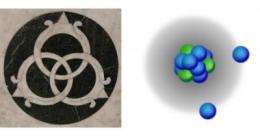Extra large carbon

An exotic form of carbon has been found to have an extra large nucleus, dwarfing even the nuclei of much heavier elements like copper and zinc, in experiments performed in a particle accelerator in Japan. The discovery is reported in the current issue of Physical Review Letters and highlighted with a Viewpoint by Kirby Kemper and Paul Cottle of Florida State University in the February 8 issue of Physics.
Carbon-22, which has a nucleus comprised of 16 neutrons and 6 protons, is the heaviest atom yet discovered to exhibit a "halo nucleus." In such atoms, some of the particles that normally reside inside the nucleus move into orbits outside the nucleus, forming a halo of subatomic particles.
Because atoms like carbon-22 are packed with an excessive number of neutrons, they're unstable and rapidly break apart to form lighter atoms, but they are more stable than scientists had previously expected. The extra stability is a surprise because the three particles-- two neutrons and a nucleus-- that form a halo nucleus interact in a way that is difficult for physicists to model due to the complicated mathematics necessary to describe so-called "three body" problems.
The unexpected stability has led to such halo nucleus atoms being labeled Borromean atoms in reference to an ancient pattern depicting three rings interlocked such that the removal of any one ring would cause all three to be disconnected. Borromean rings were often used to symbolize a stable union of three parts in traditional carvings and family crests.
The detection and analysis of carbon-22 sets a new milestone in challenging nuclear physics, and hails a promising era in the investigation of heavier and even more exotic nuclei as new beam facilities and more sensitive detectors come on line over the next decade. The surprising discovery of carbon-22's halo suggests that nuclear physicists will have plenty of new ground to cover in coming years.
More information: Observation of a Large Reaction Cross Section in the Drip-Line Nucleus 22C, K. Tanaka et al. Phys. Rev. Lett. 104, 062701 (2010) - Published February 08, 2010. Download PDF (free)
Provided by American Physical Society
















